Life in Sweden is strange. Even Swedes think it is strange. I have to admit, though, that despite all its challenges, I really like it. At first, the transition is a real struggle. I’ve yet to meet the expat who had a smooth transition. But after a while, you grow accustomed to the strangeness of it all and – with the help of some therapy and prescription drugs – you find that life in Sweden is pretty good.
_____________________________________________________
December 2008
My Town
The city of Stockholm is fantastic. There really isn’t much more that needs to be said. There are bigger cities, more vibrant cities, more multicultural cities; but when it comes to quality of life, Stockholm is hard to beat. The water and air are quite clean, there are trees and parks everywhere, and you don’t need a car at all. Bike paths are an integral part of the transportation infrastructure and the mass transit system – buses and the subway – is clean, dependable, and efficient. There are nearly a million residents in the city and nearly two million in the metropolitan area. The crime rate is rather low and I feel quite safe walking around at night. Of course, most of my nighttime walking is between the sofa and the fridge, but still I’ve only rarely felt unsafe doing that.

The Stockholm skyline is not very high, but the face of the city is beautiful.

Stockholm at night can be quite breathtaking.

This is Strandvägen as seen from Djurgården.
________________________________________________
December 2008
My Island
The following are pictures of Södermalm, which is the island on which I live. The word “söder” means south or southern and Södermalm is a large island to the south of the city center. I have no idea what “malm” means. I asked some of my Swedish friends and they didn’t know, either, which is fairly typical. Swedish is a moderately difficult language and even most Swedes use common Swedish words every day whose meaning is completely unknown to them. They just give a hearty laugh and pretend they understand each other. It keeps things interesting and serves to make immigrants feel awkward. Anyway, the dictionary says malm means ore, so perhaps Södermalm used to be a mining area. I haven’t seen any holes anywhere, but I’m always on the lookout. It is quite a beautiful neighborhood with amazing architecture, lovely parks and even a few cobblestone streets. There is a good selection of cafés, pubs, restaurants, bookstores and small shops in the area. And the streets are filled with screaming drunk football hooligans most nights, which only adds to the allure.
Aside from the pictures below, there are some pretty good pics of the neighborhood here.

My neighborhood Södermalm.

Another view of Södermalm.
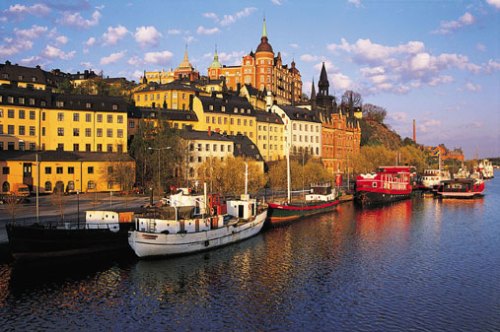
This is the typical postcard shot of Södermalm\’s northern edge.

This is Brännkyrkogatan, a typical street on old Söder not far from my flat.
_________________________________________________
December 2008
My Neighborhood – Mariatorget
The island of Södermalm is divided into various small neighborhoods, which usually are named after the church that serves the area. The nearest church to my flat is Mariakyrkan (“The Church of Maria” or probably “Mary Magdalena”), so my neighborhood is called Mariatorget, which actually means “Maria Square” or “Maria Market.” The square today is a park with statues, trees and the occasional fossilized dog poop that seems to have originated from Godzilla the Rottweiler. On that note, I am very impressed with how conscientious Swedes are about picking up their dogs’ poop when out on walks. The people here take pride in their city and work to keep a clean environment. This is nothing like Paris. In fact, the main reason I didn’t move to Paris is all the dog poop the French tend to spread throughout the city. It is a little-known secret that Paris’ Place de la Concorde was originally going to be called Place de la Grand Shit du Chien until the egomaniac Louis XV put the kybosh on those plans. Anyway, Mariatorget is a lovely park. There is a bust of a famous Swedish philosopher named Swedenborg who espoused some very interesting theories on metaphysics. My flat is right near Swedenborgsgatan or Swedenborg’s Street. (I told you there would be some boring parts.)

Mariatorget at dusk.

I love this one.

Lately, we\’ve seen a rather humorous urban art project wherein participants place knitted clothing on statues. Beats the hell out of graffiti.

This is an older picture of Mariatorget, but it looks like this today.

Behind these fine, upstanding young lads is the bust of Swedenborg. Yes, Sweden has a Nationalist Front that, to my understanding, is more active than most in Europe.
_____________________________________________________________
December 2008
Why Sweden?
I often get asked why I moved to Sweden. The obvious answer is the one that applies whenever you ask anyone why they make such a dramatic change: to improve the quality of life for my family. I felt that life in America would be wonderful for Daniel, especially in Asheville, North Carolina, where life quality in general is far better than average. But I often dreamed of life on a farm with nature all around and city stresses a distant memory. My wife, Caroline, had a farm in rural Sweden that, to my mind, was the most magical place on Earth. I figured it was a once-in-a-lifetime opportunity to provide such a wonderful life to my son. So in August of 2003, we packed up and moved to a an area of Sweden called Småland, just outside the little town of Eksjö.
I spent two years with my family in Småland and learned some tough lessons. I was never under the delusion that I was any sort of farmer. But I had spent significant years of my life in farming communities and figured I could easily make whatever minor adjustments needed to be made. And, truth be told, I really wanted to give my own identity a good shake-up. I wasn’t entirely sure who I was or even that I would be too happy about what I found out if I decided to take a close look. I looked forward to the challenge and the changes it would bring in me. But I was ill-prepared for the sense of isolation that awaited.
Outside of Stockholm, Gothenburg, or Malmö, everything in Sweden is small-town and usually has a very isolated feel to it. The nation’s landmass is large but their population is fairly small, with fewer than ten million people in a place barely larger than California. But even by Swedish standards, Eksjö is more isolated than most places. Caroline’s friends used to refer to the farm as “the farm at the end of the world.” And it was. You had to travel a couple of kilometers on a dirt road, past a large dairy farm and several vast fields and forests just to get to the place. But when you came to the end of this one amazingly dark forest and crested the hill, the world opened up and her farm sat perfectly in the lap of an amazing valley bounded by rock outcroppings, dense pine forests, and two lakes as black as pitch. There happens to be a viking-era boat sitting on the bottom of one of the lakes, but when researchers considered bringing it up some years ago, they decided that it would disintegrate soon after exposure to air, so they let it rest in its cold, dark grave. If ever there were a place ripe for haunting, this lake is it.
But the isolation I found was not limited to space. I had left my family, my friends, and my job far behind. Swedes, as a rule, are a bit reserved around outsiders and it is common knowledge that breaking into Swedish social circles is difficult. Smålanders, in particular, have a reputation for this. I was amazed at how difficult it was to make friends with the natives. This doubled my sense of lonliness, but there was a silver lining that I would soon discover.
I spent 18 months studying Swedish at the local college and it was there that I found the friends I needed. They weren’t Swedes. They were immigrants, like me, who had come from such places as Bosnia, Serbia, Romania, Eritrea, Sri Lanka, the Philippines, Iraq, Iran, Somalia, Russia, Chechnya, Syria and a few other places I fail to remember. Sweden has a very generous and welcoming immigration policy, which is somewhat odd given the personal reservedness of the citizens I mentioned a moment ago. These people were amazing. They were interesting, full of color and vibrancy, and anxious to build new friendships. Most were not casual immigrants. They had not come to Sweden to live on some beautiful farm and have a fairy-tale life. They were fleeing war, political oppression, poverty. Most had probably not even chosen Sweden at all, but were sent here because it was the only nation in Europe that would take them. Part of the Swedish immigration policy is to spread the newcomers out into remote areas of the country and certain towns are known immigration landing spots. Eksjö and two towns nearby, Aneby and Tranås are such towns. I think the policy’s attempt to diversify the nation and help those in need is admirable, but there are no jobs for these people and the majority of them wind up living on state support for years. Regardless, these people really added energy to my experience and I love them dearly for it. They opened my eyes and mind to a much larger and more interesting world.
In the end, the reality of the situation did not meet the fantasy, and it was perhaps foolish to ever think that it would. The limits I encountered were just too hard to overcome. There were too few opportunities for a person like me. So I moved to Stockholm and it was like the sun breaking through clouds after a two-year winter. Still, the experience had profound effects on me, the full extent of which I have yet to comprehend, and I am a better person for it. Not only have I changed, but I understand myself much better today than I ever have before. And you know what? I really like what I see.
A picture is worth a thousand words, and since I’ve already written over a thousand words here, I’ll let pictures of my boy on the farm – a thousand of them – fill in a few of the gaps for you. These are from 2003.

Danny with our dog, Lova. The farmhouse is typical for Sweden.

We\’d sit out and have coffee while the birds ate breadcrumbs.

I miss my dog terribly. She died last year unexpectedly.

Here you can see two of the three barns that faced the farmhouse.

The fence was handmade by Daniel\’s grandfather and grandmother.
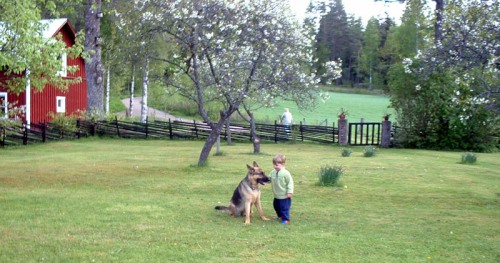
The front yard. The road goes through the forest and back to the dairy farm.

Behind them is the field where the cows grazed.

Check out all the firewood by the barns! Primitive living, that’s how we rolled.

Look at that sky. Winter is on the way.

The mountain biking in those forests was spectacular.
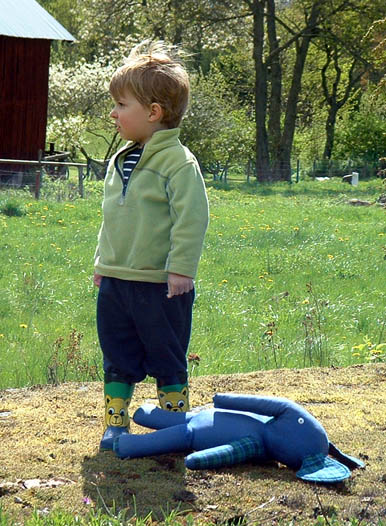
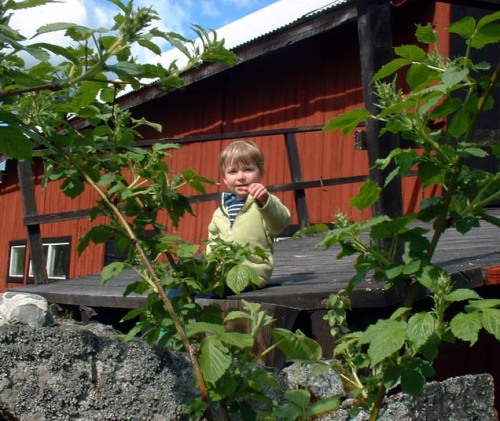
The red paint comes from copper mines in the north and is very durable.

Electricity and phone were available, but water and heat came from the farm.
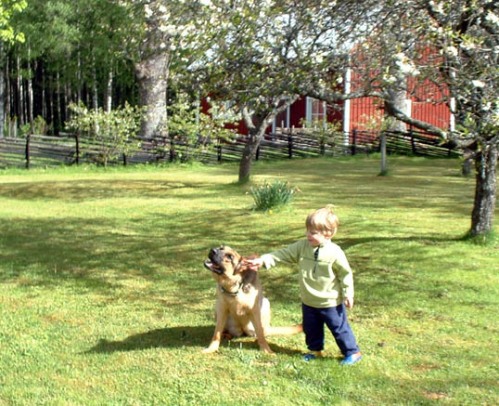
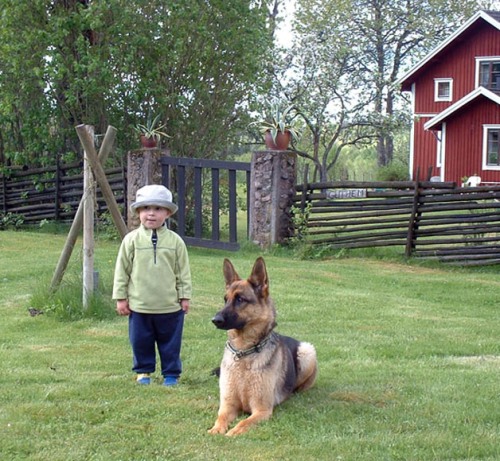
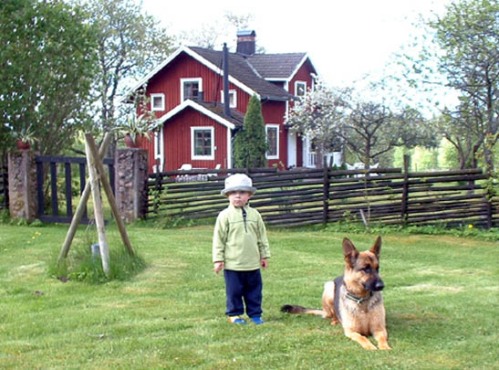

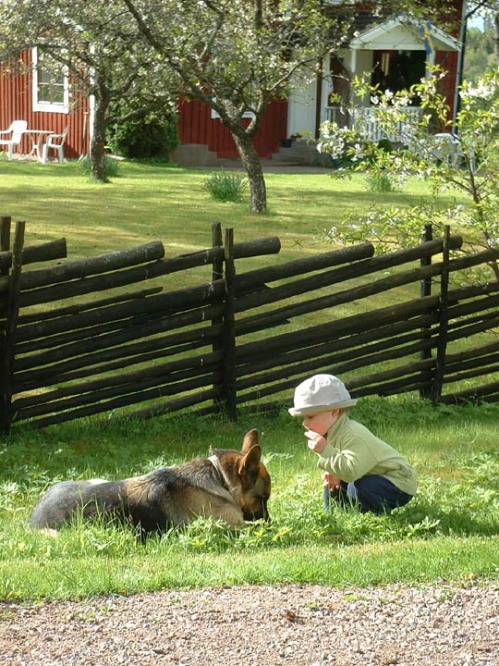


So nice pictures… I almost got emotional… my time in Eksjö was more or less five years….
By: Lene on December 6, 2008
at 4:20 pm
ok the fence is phenomenal!! and I love the pic of Daniel squatting down with Lova!
By: Deb on December 6, 2008
at 4:33 pm
What a lovely read, mate!
‘Malm’ is an old word for a sandy gravel-like area. Think of Malmö 🙂
Södermalm was originally called ‘Åsön’ but it seems it later took on its current name (in the early 1200s) to differentiate itself from Norrmalm (which was a separate city in those days), Östermalm, etc.
No mining on the island, so far as I know. But it was packed with industry and working-class house in the old days.
A marvellous read is the set of ‘Stad’ books by Per Anders Fogelström, which deals with the history of Stockholm and with plenty of focus on Söder.
By: Nic Fjord on December 7, 2008
at 1:35 am
Amazing pictures, and an evocative description of life in the city. I particularly liked the photo of the bikini’d statue – it’s so ironic. In Sweden, nude statues are the least of people’s concerns!
By: Adriaan on December 8, 2008
at 10:00 am
*Wow Nic, you seem to know a lot about Söder considering you hate it so much! 🙂
Nice farm Scott/Samuel!
By: Rob on December 8, 2008
at 10:52 am
So what’s the deal with the vacuum and duct tape? You had a broken Electrolux, and decided to find it’s home?
By: Stephen Austra-Beck on May 9, 2009
at 11:38 pm
What lovely photos! I’ve been an expat for six years now (Southeast Asia, Scotland, Middle East) and am beginning to wonder if I’m reaching my “expiration date” for being an expat, even though I know I won’t ever really fit in at home (the US) again. It’s nice to see an expat blog so different.
By: B.B. Saenz on August 23, 2010
at 2:14 pm
I want to travel to Europe soon and want to visit Sweden. I heard it’s very expensive. Is it true? That is my main concern.
Thank you,
Linda
By: Linda on October 14, 2010
at 8:38 am
Thank you for sharing the photos and the cultural experiences! It is rewarding and very pleasant….good for you to have experienced life in Sweden!
By: Monty Westmeyer on January 5, 2011
at 5:39 pm
Hello from Boston,
Thanks for sharing your experiences. Great insights to consider for your fellow travelers thinking of moving to Sweden.
By: Chris on March 31, 2013
at 11:42 pm
The photos of youyr son are beautiful. Thank you for sharing your experiences moving to a new country. I will be living in Sweden soon, I dread not making new friends once i leave everything behind,knowing that Swedes are more reserved than Americans.I look forward to my language courses and making friends there .
By: carmen on October 5, 2014
at 9:29 pm